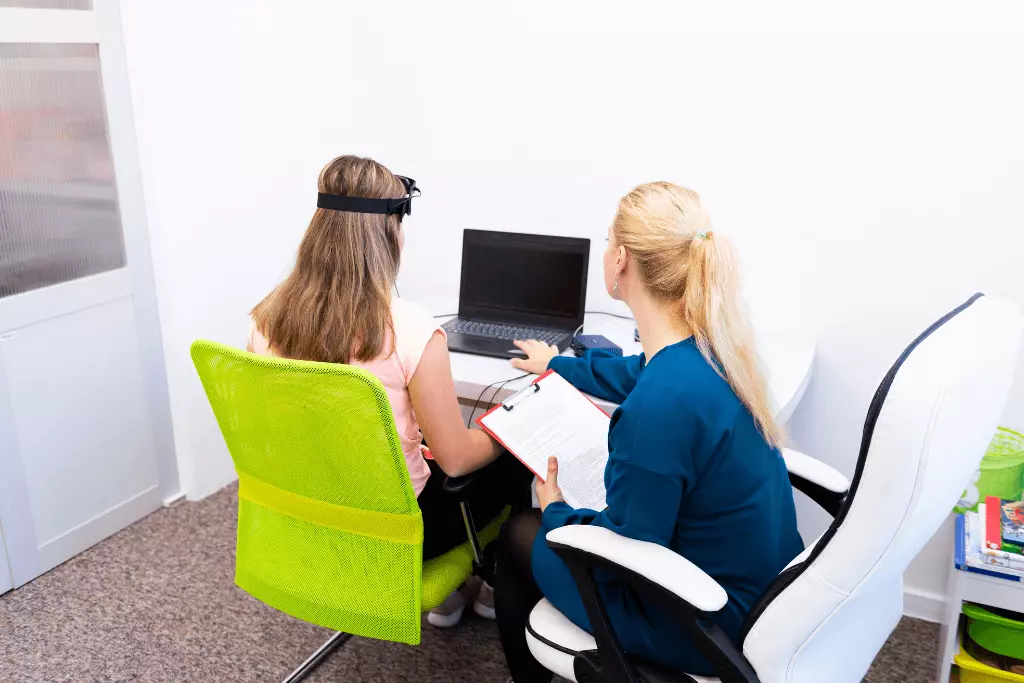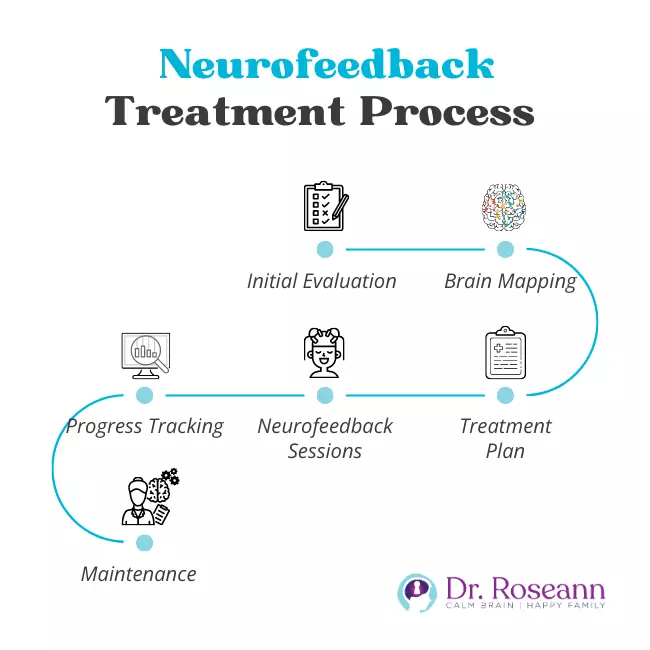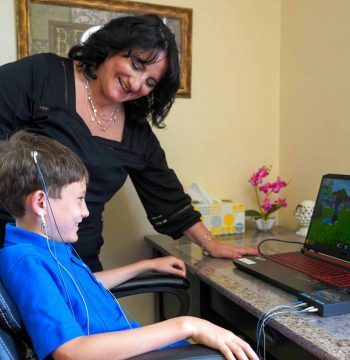You may be considering neurofeedback as a natural treatment option for your child with a neurodevelopmental, processing, or learning disorder. And you should because neurofeedback is a treatment with a proven track record of improving brain functioning without any harmful side effects like those that come from psychiatric medications.
You may be asking yourself, “What exactly is neurofeedback?” Neurofeedback is a therapy that uses real-time brain activity monitoring to teach self-regulation of brain functions. It involves using electrodes attached to the scalp to measure brain activity, fed back to the patient through visual or auditory cues.
Also known as EEG biofeedback, neurofeedback is a non-invasive technique that uses electroencephalography (EEG) to monitor the brain's electrical activity and provide visual or auditory feedback to the patient.
The feedback is usually provided through sounds, images, or video games that change in response to the brain's activity. For kids, it engages their brains with movies and shows that play or doesn't play based on whether or not the brain is regulating.
Neurofeedback aims to help individuals learn how to self-regulate their brain activity to improve attention, behavior, mood, and cognitive performance. It works to soften less desirable behaviors and enhance a child's strengths.
The research shows us that neurofeedback is effective in reducing symptoms of autism, ADHD (attention-deficit hyperactivity disorder), SPD (sensory processing disorder), and LD (learning disorder) in children.
In all of these conditions, the brain displays poor brain communication, and neurofeedback is a great method that improves how the brain communicates with itself. When the brain's communication center works optimally, a child can learn, think, and pay attention more efficiently and effectively.
How Does Neurofeedback Work?
During a neurofeedback session, sensors are placed on the person's scalp to measure the brain's electrical activity. The signals are amplified and processed by computer software, which provides real-time feedback to the person about their brain activity.
The feedback is usually presented by video playing, where the person's brain waves control the video playing or not. For example, if the child tries to increase their focus, the screen becomes bigger, and when they aren't, the screen shrinks.
The reinforcement will only be given when the brainwaves are in the desired range, encouraging the child to learn to regulate their brain activity to achieve the desired outcome. Over time, the brain learns to regulate its activity more effectively with repeated neurofeedback sessions. Those sessions are the equivalent of building muscle at the gym, you need repetition and reinforcement to build a healthy combination of brain waves.
Neurofeedback can target specific brain areas, such as the prefrontal cortex, responsible for executive function and decision-making, or the amygdala, responsible for emotional regulation. By training specific areas to function more effectively, children can experience improvements in their overall well-being and quality of life.
6 Benefits of Neurofeedback
Neurofeedback is a well-established therapy that benefits children, teens, and adults with various mental health conditions. It can help reduce various symptoms that interfere with children's learning and function in life.
Here are some of the benefits of neurofeedback:
1. Increased Attention and Focus
Neurofeedback trains individuals to increase the production of beta waves in the brain, which are associated with focused attention and alertness. Think about how it feels when you have a great night of sleep, and your brain is alert and ready… that is what beta training can feel like.
2. Reduced Anxiety and Depression
Children and teens with anxiety and depression often have an overproduction of alpha waves in their brains, associated with low motivation and disengagement. Anxious individuals may also have excessive brain communication or too much beta. Neurofeedback effectively reduces anxiety and depression symptoms in individuals with these conditions.
3. Enhanced Cognitive Performance
Neurofeedback therapy can target theta waves associated with relaxed and meditative states. The treatment trains the kids to increase their production of theta waves in the brain. As a result, it helps improve creativity, intuition, and insight. It also can enhance focused beta and brain communication to help increase processing speed. These brain waves support essential cognitive functioning aspects.
4. Better Sleep
Neurofeedback can target alpha waves associated with relaxation. It also trains children to increase their production of alpha waves in the brain to help them get restful sleep. It can also reduce anxious brain waves to turn off anxious thoughts to prepare one for sleep.
5. Reduced Chronic Pain
Chronic pain is often associated with changes in the brain's neural activity. Neurofeedback can help regulate and modify these activity patterns. Many people with chronic pain experience high levels of anxiety that exacerbate their pain, which can be addressed with brain training.
6. Improved Emotional Regulation
Neurofeedback is designed to encourage the patient to produce more specific brainwaves, such as alpha or beta waves, and discourage the production of other less beneficial brainwave patterns, such as high-frequency beta waves or daytime low-frequency delta waves. By doing so, they will be better able to regulate their emotional outbursts and reduce feelings of stress, anxiety, and negative emotions.
Neurofeedback for Autism
Autism Spectrum Disorder is a complex neurological and developmental disorder that affects communication, social interaction, behavior, and sensory processing. It is called a “spectrum” disorder because it can manifest in many ways, from mild to severe.
Autistics struggle with social interactions, such as making and maintaining eye contact, understanding nonverbal cues like facial expressions, and developing friendships. They may also have repetitive behaviors and restricted interests, such as obsessively focusing on a particular topic or activity. Autism is typically diagnosed in early childhood, and the severity and specific symptoms can vary widely among individuals.
Oliver is a teen with autism who began to communicate with his parents more connectedly after neurofeedback. Until he did neurofeedback, Oliver was only capable of repeating back or echoing what he heard, but now he could actually contribute to conversations. The quality of his life and his family has dramatically improved, and his teachers can barely keep up with Oliver's leaps!
How Neurofeedback Helps Children with Autism
Children with autism experience difficulty with attention and focus. Neurofeedback can help them regulate their brainwaves to improve their ability to sustain attention and resist distraction. It can be a powerful method in calming overfocused brainwaves and reducing rigidity in the brain and behavior.
Research has also shown that neurofeedback can help reduce hyperactivity and impulsivity in individuals with autism. In addition, by teaching individuals to self-regulate their brain activity, they may be better able to control their behavior and respond more appropriately to social situations (Wigton & Krigbaum, 2015).
Neurofeedback may also help reduce anxiety, obsessive tendencies and improve sleep in individuals with autism, which are common challenges associated with the disorder. In addition, by teaching individuals to regulate their brainwaves, they can better manage their emotional responses and achieve greater calm and relaxation.
Neurofeedback for ADHD
ADHD affects children and adults. It's a neurodevelopmental disorder characterized by inattention, impulsiveness, and hyperactivity symptoms. These symptoms can significantly impact daily functioning, causing school, work, and relationships difficulties.
The day-to-day struggles of a child or teen with ADHD are very real. Constantly being behind and forgetting things is hard on a child and typically impacts the parent-child relationship.
Although stimulants and non-stimulants are commonly used to manage ADHD symptoms, they may not be suitable for everyone and can have undesirable side effects. Neurofeedback is a science-backed treatment option for ADHD that can be a safe and effective alternative to medication-based treatments.
Martina didn't get diagnosed with ADHD – Primarily Inattentive Type until college, but the signs were there. She was smart, but her procrastination was too much for her parents to bear. By the time she got to college, Martina had become overly confident in completing it in the 11th hour, and she was failing more than one class. After a horrible semester, her parents pulled Martina and put her in our BrainBehaviorReset™Program. After brain and executive functioning training, Martina returned to college, and with a regulated brain, she had the brain and skills to succeed.
How Neurofeedback Helps Children with ADHD
Neurofeedback offers an alternative to medication by acting as a personal trainer for your child's brain waves. The brain produces different types of waves depending on its level of focus. Neurofeedback is designed to help the brain learn to shift more efficiently into a state of concentration by teaching it how to produce the brain waves associated with focus.
Through neurofeedback, children with ADHD can improve their ability to focus, control impulses, and reduce distractions. Over time, this training can help the brain to self-regulate and produce a healthy combination of brainwaves, resulting in lasting changes.
Neurofeedback can help children feel calmer and more in control of themselves. Additionally, the use of quantitative electroencephalogram or QEEG testing can be beneficial in diagnosing ADHD and can provide valuable insights when planning EEG biofeedback therapy and monitoring its efficacy (Ochojska et al., 2021).
Neurofeedback for SPD
Children with SPD may experience difficulty processing and responding to sensory information they receive through their senses, such as auditory, visual, vestibular, tactile, olfactory, gustatory, and proprioception.
These children may be oversensitive or undersensitive to sensory stimuli in their environment, which can affect one or more sensory systems and create one or more sensory sensitivities. Children with SPD may experience sensations too intensely or quickly, leading to avoidance or seeking of specific sensory experiences.
Their motor planning and skills may also be affected, creating challenges in everyday tasks. For instance, children with SPD may be oversensitive to sights, sounds, textures, flavors, smells, and other sensory inputs, leading to avoidance of specific clothing or food textures.
Simple tasks such as getting dressed may become overwhelming for a child with SPD, causing tears and meltdowns due to an overloaded system, which can trigger anxiety or discomfort. In addition, these children may respond with behaviors because they have difficulty connecting their feelings with their bodies.
How Neurofeedback Helps Kids with SPD
Sensory sensitivity is a common trait in neurological disorders that involve hyper coherence or overcommunication within the brain. These conditions can be identified through a QEEG brain map.
The QEEG brain map is a diagnostic tool that assesses brainwave activity and identifies brain areas that may be either under-stimulated or overstimulated. This process eliminates any guesswork involved in the diagnosis and makes it easier for neurofeedback to target the right brain areas.
Neurofeedback for LD
There are different learning and processing disorders, but dyslexia is one of the most prevalent learning disabilities. It is also a learning problem that is frequently misidentified and misconstrued.
Although children with a learning disability can read and understand lessons to a certain extent, their abilities are typically subpar. They struggle with reading fluency and automaticity. That means they are slow and lack accuracy when reading.
Early recognition of their phonetic difficulties and providing targeted, intensive, and explicit multisensory interventions can help these children. Conversely, adopting a wait-and-see approach increases the difficulty in addressing the root causes and inflicts emotional strain on these children.
I have had the privilege of doing neurofeedback with many dyslexic families because it runs in families. About 15 years ago, Georgie and his dad Derek came together to do neurofeedback to improve their sluggish brain processing. It was terrific to see father and son improve how they read and begin to enjoy reading for the first time in their lives.
How Neurofeedback Helps Children with LD
Children with learning disabilities may show hypoactivity and hyperactivity in their brainwave patterns. Efficient information processing requires rapid communication between key brain areas involved in learning and processing. By improving connectivity between these areas, the brain can work more efficiently.
Neurofeedback training can help enhance brain activity self-regulation, leading to better connectivity and timing. In addition, it improves learning, particularly in areas of the brain involved in phoneme processing.
Neurofeedback Treatment Process
Neurofeedback treatment typically involves several steps. These are:
1. Initial Evaluation
The first step is an initial evaluation, which includes a clinical interview, and questionnaire to assess the child's symptoms, goals, and baseline brainwave activity.
2. Brain Mapping
The next step involves a QEEG, a non-invasive brain mapping procedure that measures electrical activity in the brain. It provides information about which brain regions may be overactive or underactive and which brain waves may be out of balance. For those that aren’t local or fully virtual, we do a brain check where we take averages in certain brain regions once the client gets the equipment.
3. Treatment Plan
A care plan is personally developed by Dr. Roseann based on the initial evaluation and brain mapping results. This plan will be individualized to the child's needs. It may involve specific protocols to target certain brain waves or areas of the brain and therapies that need to support the behaviors.
4. Neurofeedback Sessions
During the neurofeedback sessions, electrodes are placed on the scalp to measure the child's brainwave activity, and the child will engage in a task or activity that provides real-time feedback, which reinforces the brain when it produces the right combination of healthy brain waves.
For example, the child may watch a movie or play a game that responds to changes in their brainwave activity. The goal is to reinforce desirable brain activity patterns and teaching the brain to regulate itself more effectively. This process is pleasant and easy for children.
5. Progress Tracking
Progress is tracked throughout the treatment process using subjective reports from the patient and objective measures such as follow-up QEEG scans. Adjustments to the care plan may be made as needed based on progress and feedback from the child, and in our program, one’s brain reset specialist works closely with you to support your program.
6. Maintenance
Once the treatment plan is completed, maintenance sessions may be recommended to help maintain the gains made during treatment, or additional methods can support the brain and mitigate stress.
Our clinic in Ridgefield, CT, utilizes neurofeedback to assist parents of children with mental health conditions, calm their brains, improve behavior, and decrease family stress. We also do remote treatment sessions with families all over the world.
Natural Ways to Support the Brain
When you have a child with special needs or who is struggling with attention, learning, or behavior, you want the best for your child. Psychiatric medication should never be the first choice because the research shows that a parent can do so much.
Most parents are surprised about how many ways they can help their child naturally, even when they have clinical issues such as ADHD, executive functioning, anxiety, mood, and so on.
Having helped thousands of kids and parents, we have many resources to support parents like you. Taking our solution matcher is the best way to see the right resource.
Citations
Ochojska, D., Dejnowicz-Velitchkov, A., & Kopańska, M. (2021). Diagnosing ADHD using QEEG and planning EEG-biofeedback (Neurofeedback) therapy – pilot studies. Medycyna Ogólna I Nauki O Zdrowiu. https://doi.org/10.26444/monz/131993
Wigton, N. L., & Krigbaum, G. (2015). Attention, Executive Function, Behavior, and Electrocortical Function, Significantly Improved With 19-Channel Z-Score Neurofeedback in a Clinical Setting: A Pilot Study. Journal of Attention Disorders, 23(4), 398–408. https://doi.org/10.1177/1087054715577135
Always remember… “Calm Brain, Happy Family™”
Are you looking for SOLUTIONS for your struggling child or teen?
Dr. Roseann and her team are all about solutions, so you are in the right place!
There are 3 ways to work with Dr. Roseann:
You can get her books for parents and professionals, including: It’s Gonna Be OK™: Proven Ways to Improve Your Child’s Mental Health, Teletherapy Toolkit™ and Brain Under Attack: A Resource For Parents and Caregivers of Children With PANS, PANDAS, and Autoimmune Encephalopathy.
If you are a business or organization that needs proactive guidance to support employee mental health or an organization looking for a brand representative, check out Dr. Roseann’s media page and professional speaking page to see how we can work together.
Dr. Roseann is a Children’s Mental Health Expert and Therapist who has been featured in/on hundreds of media outlets including, CBS, NBC, FOX News, PIX11 NYC, The New York Times, The Washington Post,, Business Insider, USA Today, CNET, Marth Stewart, and PARENTS. FORBES called her, “A thought leader in children’s mental health.”

She is the founder and director of The Global Institute of Children’s Mental Health and Dr. Roseann Capanna-Hodge. Dr. Roseann is a Board Certified Neurofeedback (BCN) Practitioner, a Board Member of the Northeast Region Biofeedback Society (NRBS), Certified Integrative Medicine Mental Health Provider (CMHIMP) and an Amen Clinic Certified Brain Health Coach. She is also a member of The International Lyme Disease and Associated Disease Society (ILADS), The American Psychological Association (APA), Anxiety and Depression Association of America (ADAA) National Association of School Psychologists (NASP), International OCD Foundation (IOCDF) International Society for Neurofeedback and Research (ISNR) and The Association of Applied Psychophysiology and Biofeedback (AAPB).
© Roseann-Capanna-Hodge, LLC 2023
Disclaimer: This article is not intended to give health advice and it is recommended to consult with a physician before beginning any new wellness regime. *The effectiveness of diagnosis and treatment vary by patient and condition. Dr. Roseann Capanna-Hodge, LLC does not guarantee certain results.














